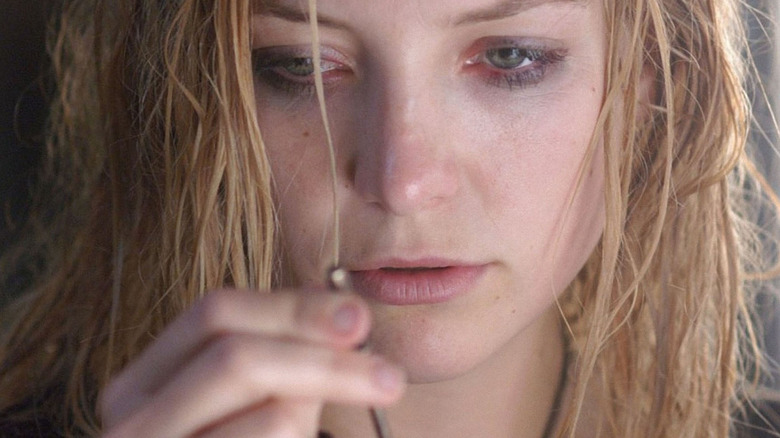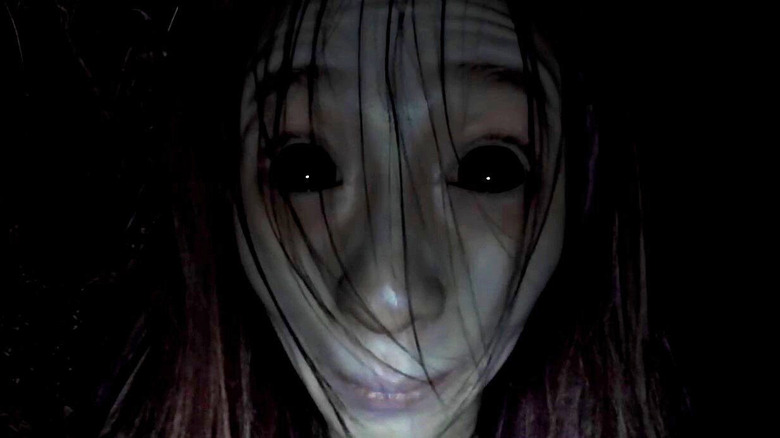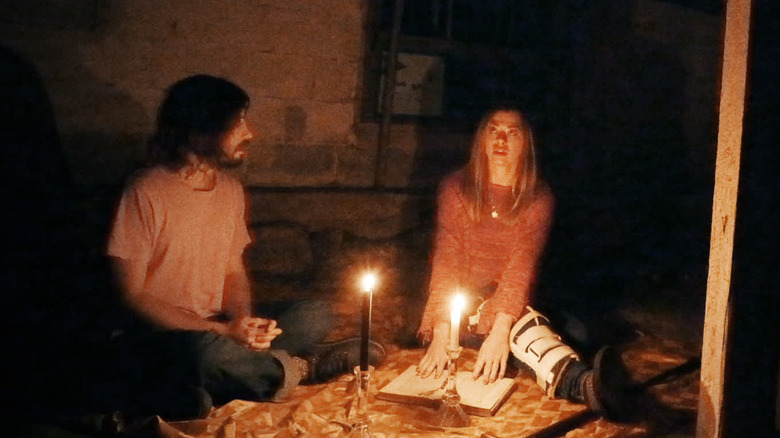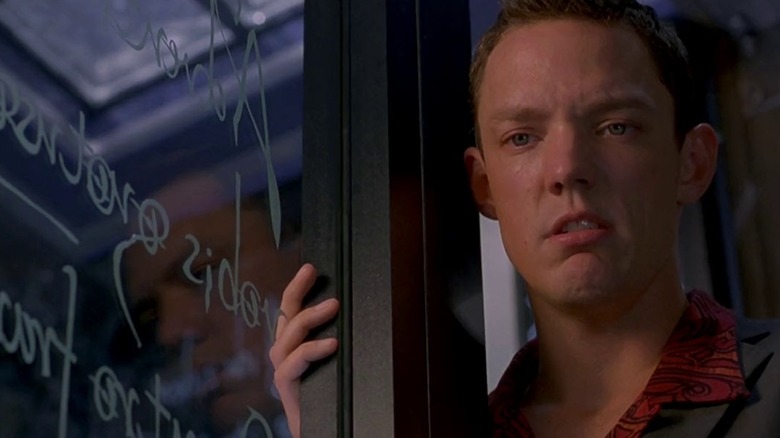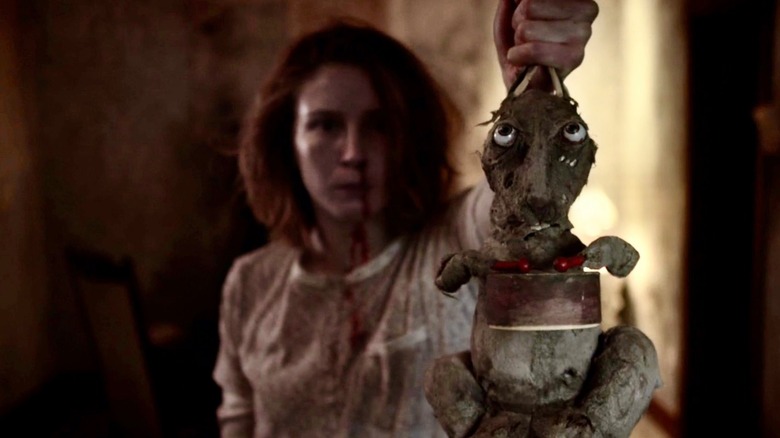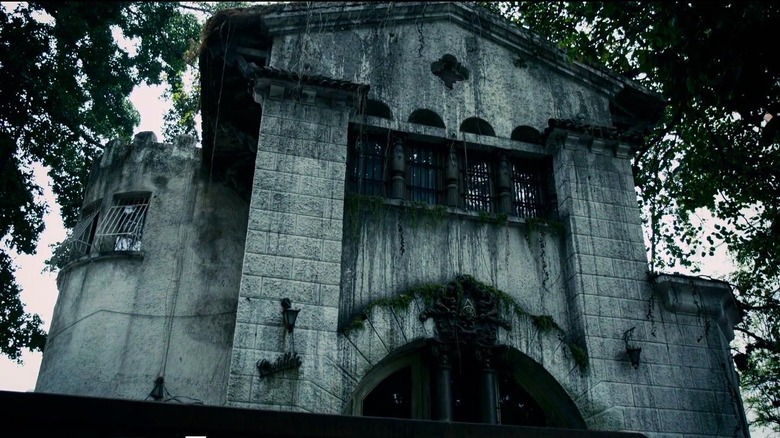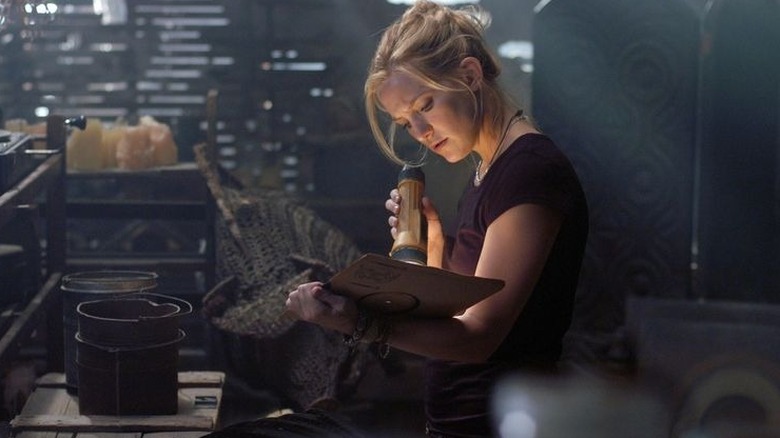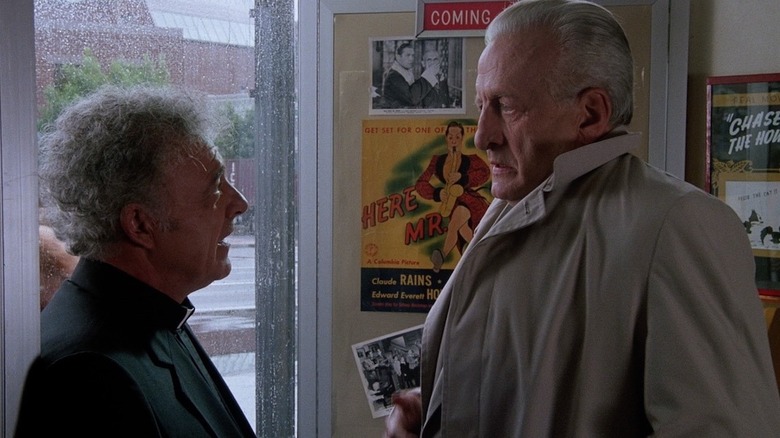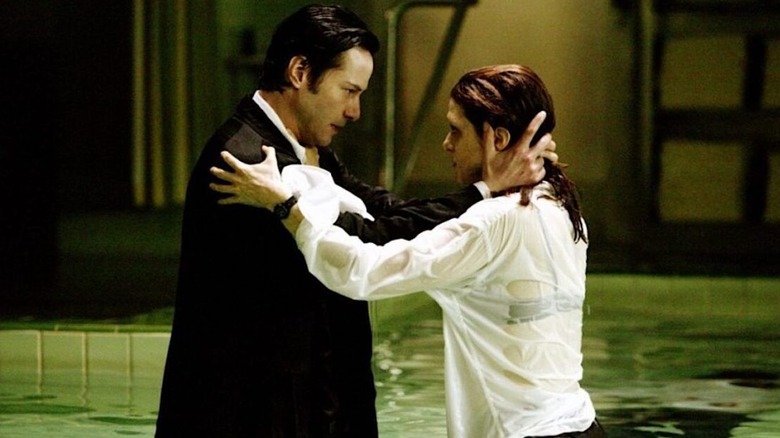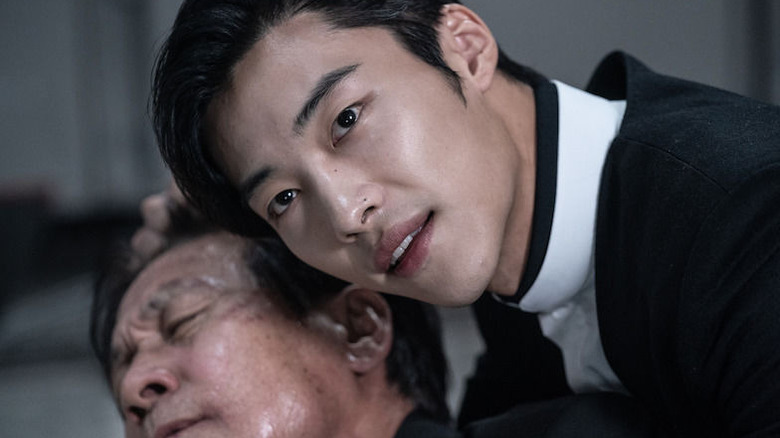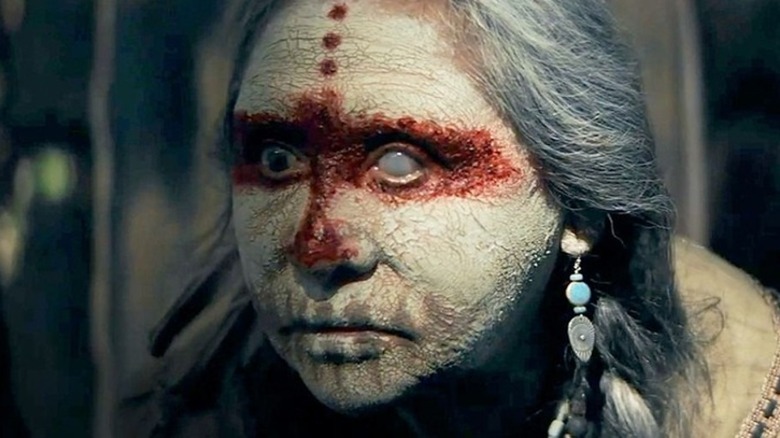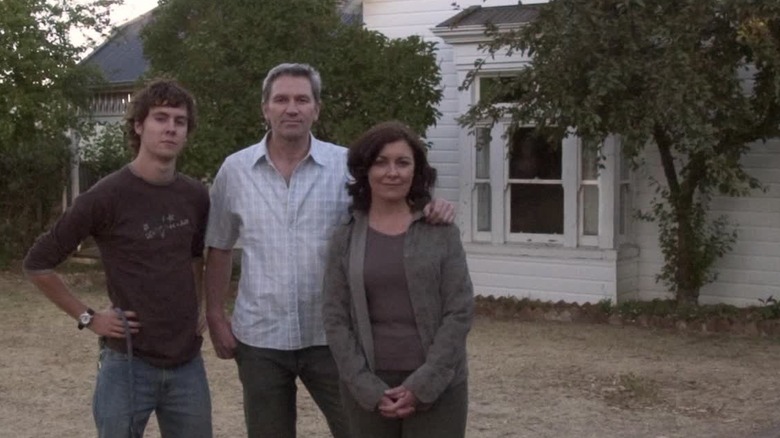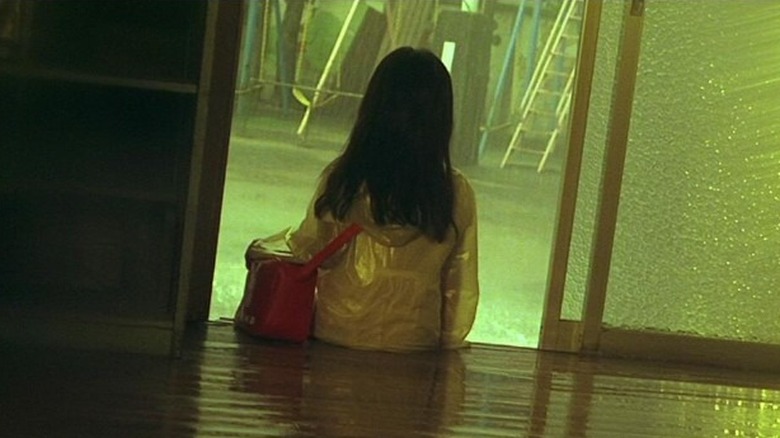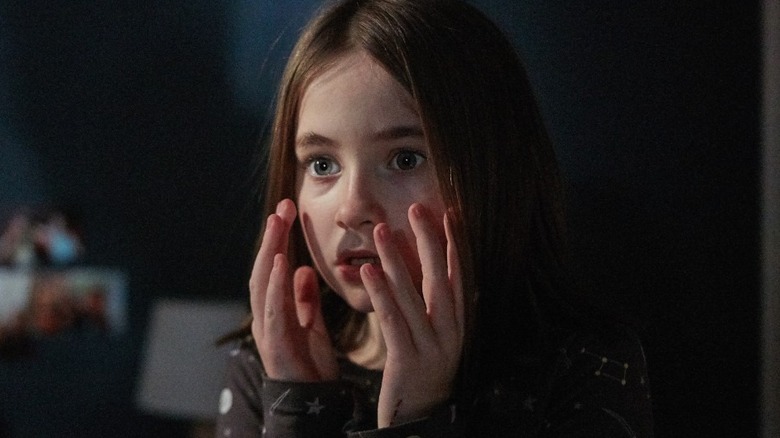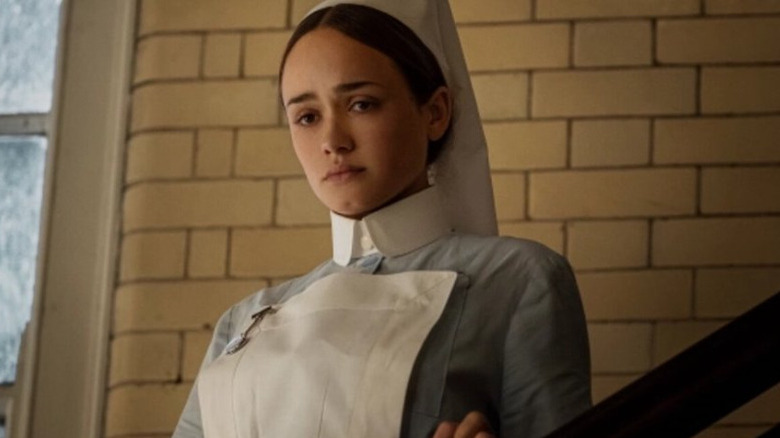Underrated Haunting Movies To Watch If You Loved The Conjuring
Whether you love or hate James Wan's "The Conjuring," it's impossible to deny the impact the 2013 film had on horror. Wan fused atmospheric scares with Joseph Bishara's string-filled and spine-tingling score to craft a part-haunted house, part-possession film that jump-scared its way into earning more than $320 million at the worldwide box office. By 2021, "The Conjuring" franchise has earned $2 billion, as confirmed by Deadline.
While "The Conjuring" was marketed as a story based on true events, Wan and co-writers Chad Hayes and Carey W. Hayes took several creative liberties when bringing the Warrens' investigation of the Perrons' family house to life. (For example, the film's exorcism of Carolyn Perron never happened.) Although it's true that Ed and Lorraine Warren conducted hundreds of paranormal investigations, their validity as ghost-hunters has never been confirmed. Also, as THR documented in 2017, the real-life Warrens' story has plenty of disturbing facts off-screen. For fans wondering where else they can turn to find similar haunting thrills that don't support their troubled legacy, look no further.
If you're a fan of "The Conjuring" and craving more ghouls, here are some underrated haunting gems that deserve a watch. The films below each uniquely tackle possession, and hauntings, and explore the role that family plays when things take a supernatural turn for the worse. Some are more frightful than others, but all invoke the unpredictable powers of ghosts or demons and what happens when humans face them.
Gonjiam: Haunted Asylum
Made on a budget of $2.2 million, 2018's "Gonjiam: Haunted Asylum" grossed more than $20 million at the global box office. The Korean horror film became a blockbuster hit in South Korea, rivaling that of the beloved classic "A Tale of Two Sisters." However, the fanfare for this found-footage-style paranormal investigation film didn't rank nearly as high in the U.S., bringing in roughly $115,000 to the domestic box office. Despite that lukewarm reception in the States, it's wholly deserving of a first watch (or rewatch) for those that love each moment a ghost or entity embodies someone in "The Conjuring."
Unlike James Wan's film, director Jung Bum-shik modernizes his take on a paranormal investigation that's also based on a reportedly haunted place. In 2012, CNN reported that the Gonjiam Psychiatric Hospital in Gyeonggi, South Korea was one of the scariest places in the world, which led co-writers Jung Bum-shik and Park Sang-min to craft a film around YouTubers exploring it solely based on that article. While the filmmakers didn't obtain permission to shoot within the hospital, they recreated scenes using its floorplans to make them as realistic as possible. While the real-life building is now demolished, "Gonjiam: Haunted Asylum" continues its terrifying reputation. Of all the film's on this list, this one is not for the faint of heart. Its possession scenes range from quietly disturbing to nausea-inducing, and it takes plenty of joy in seeing how far its creepy ghosts can toy with its YouTubers.
Curse of Aurore
Similarly, 2021's "Curse of Aurore" takes a found footage approach to exploring a haunting (and true) piece of history. Filmed in Quebec in the actual family house of its star Llana Baron, "Curse of Aurore" creates a film about making a horror film. The movie takes its time developing its scares as the filmmakers search for what their film will be about. Along the way, the three filmmakers stumble into the infamous and tragic history of Aurore Gagnon, a young girl in the 1900s who was savagely and slowly tortured by her parents until she died. The film uses its format as a way to investigate Fortierville, Aurore's troubled spirit, and what happens when outsiders try to intervene in local matters.
What works best about this movie is its subtle use of ghostly figures and scares. You could make a solid game at trying to catch all the ghosts that are off-center in shots or making mischief in the background. While there are certainly some VFX at work here, there's a handful of inventive practical effect scenes with ghouls that are far more unsettling than some of the cinematic ghost reveals in "The Conjuring." Whereas you'll certainly remember the ghosts of "The Conjuring" and when they appear, "Curse of Aurore" will have you second-guessing which ones you've missed and exactly when the haunting truly began.
Thirteen Ghosts
Over the past decade, the 2001 remake of William Castle's "Thirteen Ghosts" has finally earned cult classic status, especially among horror fans that like to have a little fun in bloodshed. It's incredibly easy to fall in love with "Thirteen Ghosts" for its detailed approach to its supernatural mythos, its murder-box design of a house that'd make Pinhead squeal with joy, and the pitch-perfect chemistry between stars Matthew Lillard and Tony Shalhoub. The pair's acting styles — Lillard, of course, chews the scenery, whereas Shalhoub remains astutely understated until the moment calls for an outburst — mesh fascinatingly well.
It's worth noting that director Steve Beck director pulls off something that "The Conjuring" failed to land: It told a heartwarming tale about the power of the Kriticos family's unconditional love. In "The Conjuring," Ed and Lorraine save the day by toting out horror's well-worn magical priest trope (even though Ed Warren in real life was never ordained or given permission to conduct exorcisms) and bless the evil away for the Perrons. The family is helpless to save themselves. However, "Thirteen Ghosts" proves Catholicism isn't the only way to cast out the darkness. Turns out, the selfless love of a father can beat a bloodthirsty juggernaut if the need arises. While James Wan's film centers on the Perron family, its story is about what happens to them; Beck's film showcases how the Kriticos family overcomes grief and unimaginable horror to survive for one another.
Caveat
If you're wary of any horror movie with a paranormal investigation team, "Caveat" just might be your answer. While director Damian Mc Carthy's debut feature film is more about the dangers of trusting others than exorcisms, it nevertheless features a chilling spirit and an unsung ghost-hunter: Meet the drummer bunny. Mc Carthy said in 2021 that he thought it'd be "cool" if there was a toy that could "always tell if there was a ghost in the room." That's exactly what this toy bunny does, kickstarting Olga's journey to discover who is haunting her home. What's most impressive about this dialed-down approach, especially in comparison to "The Conjuring," is the audience gleans how this toy works without being told by someone like the Warrens. This choice allows viewers to feel like vicarious investigators, intuiting their own theories of the logic of this creepy and tragic world.
When "Caveat" tips its hand into what's happening in Olga's home, its central ghost shares some of James Wan's style. The movie used practical effects for its ghost, casting dancer Inma Pavon in the role of a being who often smiles, moves incredibly slowly, and enters the scene with string-filled scores that'll give viewers goosebumps. The film's pacing is comparatively slower than "The Conjuring," matching up more with the 2013 film's first atmospheric act. But if a building sense of dread is what you're seeking, "Caveat" has it in spades.
The House at the End of Time
During the same year "The Conjuring" debuted, director and writer Alejandro Hidalgo released the highest-grossing film in Venezuelan history, "The House at the End of Time." Following its release, horror critics didn't flock to this one as kindly — calling it "rough around the edges" — or as widely. Some criticized it for leaning too much into aesthetics than substance, whereas others felt impatient with the film's unspooling and timey-wimey mystery. In a sense, it's fair to say that "The House at the End of Time" isn't an easy film to watch, particularly from the point-of-view of lead character Dulce, who has no idea what's happening to her or her family. Dulce has premonitions and believes her house is cursed. In order to understand how these two things connect, the audience has to sit through plenty of seemingly contradictory moments. That patience will pay off, but likely not in the way you imagine.
That being said, "The House at the End of Time" excels as a haunted house/mystery box of a film that rewards repeat viewings. The journey of watching it feels like a slow descent down a spiraling staircase that you know will lead to something even darker and it's your curiosity that keeps you going. For "The Conjuring" fans who delighted in watching how a family survives a haunted house, this pick will satisfy that urge and deliver a uniquely moody vibe.
The Skeleton Key
One thing that doesn't get spoken about too much in regards to "The Conjuring" is how it cherry-picks data around land rights. As discussed best in "The Gaylords of Darkness" podcast by Anthony Hudson, the 2013 horror film stops its investigation into the Perrons' homeland right at colonial times when Bathsheba Sherman presumably lived and did (or didn't) stir cauldrons. "The Conjuring" never answers if Bathsheba was an actual witch or, like the real-life Salem Witch trials, was killed for being an outspoken woman and became a witchy spirit. There's no mention of indigenous land rights or cultures pre-Bathsheba, and no interest in digging deeper into how colonialism and whiteness changed their landscape.
In 2005, director Iain Softley crafted "The Skeleton Key," a possession film that more openly tackles race than most horror. "The Skeleton Key" follows a hospice nurse named Caroline who travels to the Terrebonne Parish plantation to take care of Violet Devereaux and her husband Benjamin. However, once Caroline arrives, she discovers some mysterious Hoodoo books and becomes determined to figure out what's happening in the Devereaux home. What works best about Softley's film is how it shows the persistence and arrogance of whiteness, and Caroline learns exactly what happens when you trot into a world that's not yours seeking to fix it. Filmed on the real-life Felicity Plantation, "The Skeleton Key" isn't perfect in its examination of slavery and racism, but it nevertheless and admirably tries with its cautionary tale.
The Exorcist III
1990's "The Exorcist III" invented the requel way before 2018's "Halloween," and did so without undermining any of its leads' backstories. Written and directed by William Peter Blatty, "The Exorcist III" serves as a direct sequel to the original film and ignores all the events of "The Exorcist II: The Heretic." Instead of focusing on Regan, the film focuses on Father Dyer and Lt. Kinderman's lives 15 years after the events of the first film. These two supporting characters gain a fully realized story in "The Exorcist III," which expands the mythos of the franchise in a thoughtful way, giving a wider scope to the aftermath of the first film. It's a bold and fascinating move as we see how these men of the law and faith vastly disagree on how to see the world but nevertheless are bonded by their belief in the beyond.
Additionally, the film works wonderfully as an unfulfilled queer love story between the two leads as they investigate what is either a serial killer or a demonic force plaguing their town. "The Exorcist III" is a great pick for fans of "The Conjuring" who preferred the flavor of its first act — cautious and full of impending doom. While the film takes its time to deliver its good vs. evil face-off, it's worth the wait and doubles the impact for those who've also seen "The Exorcist," thanks to the film's surprise and gut-punching reveal at its very end.
Constantine
In "The Conjuring," Ed and Lorraine see their divine duties as a blessing, even though it painfully debilitates Lorraine any time she uses her powers. The Warrens don't seem to mind (or discuss on-screen) how hard it is to live a life surrounded by death. Throughout "The Conjuring," the Warrens profess that God's love will heal all evils and they piously believe that's enough. That's certainly not the case for the chain-smoking and quippy John Constantine. In the 2005 DC Universe film "Constantine," seeing and exorcising demons is John's curse. Unlike the Warrens, John has no problems discussing how he never asked to be a hand of God. He's angry that his last days on Earth are bound-up in an epic battle between Heaven and Hell.
Eventually, John sets aside his reluctance to help others, but it's his journey to get there that makes the watch worthwhile. The Francis Lawrence-directed film brings the same battle of good vs. evil that we see in "The Conjuring" to the stage, but it does so with more nuance. Not all angels are good, and not all who practice the dark arts are wholly bad. Plus, it spares on expense in fusing high-octane action scenes with the supernatural world. Also, it's possible that John exists in the world of the Warrens. Beyond these franchises being owned by Warner Bros. and produced by DC — making it easier for IP crossovers — the Warren's haunted Annabelle doll makes a cameo in both James Wan's "Aquaman" and David F. Sandberg's "Shazam!"
The Divine Fury
While "Constantine" has plenty of demon-fighting action, it can't compare to 2019's "The Divine Fury." Similarly, the film follows a faithless man who is ironically tasked with the ability to exorcise demons. But this time, exorcisms don't need "Bible" verses or Lorraine's rosary beads. All they need in Kim Joo-hwan's film is a solid boxing combo. After a tragic accident robs him of his father at a very young age, Yong-hoo doesn't believe in God. He channels all his feelings into dominating the boxing ring. His beliefs change, though, when he meets and unwittingly saves a priest from a demonic attack.
Yong-hoo is nothing like Ed Warren, and that's a great thing. "The Divine Fury" acknowledges but cleverly dispels the magic priest trope in horror. Our priest in this film is helpful but doesn't save the day. The power lies in the individual to succeed regardless of religion. Sure, Yong-hoo examines his faith with Father Ahn, but he never needs to convert to Catholicism to gather the inner strength he needs to fight demons. Yong-hoo's fist is the weapon, not faith.
An often overlooked part of "The Conjuring" is how its "true story" weaponizes faith. It argues that Catholicism is the only way to be saved. Nowhere in the franchise's film series are other religions validated. Throughout its narrative, "The Divine Fury" proves how isolating that perspective can be, and it pushes the possession subgenre to be more inclusive.
The Old Ways
Set in Veracruz, Mexico, "The Old Ways" is a wonderful example of how an exorcism film can work outside the traditional bounds of Catholicism. Written by Marcos Gabriel and directed by Christopher Alender, "The Old Ways" follows a possessed L.A. journalist named Cristina who travels back to her ancestral village to document their beliefs around a haunted cavern that she believes is wholly fictional. Not too soon after arriving in town, Cristina falls victim to a nasty demon attack. What follows next is an intriguing demon-fighting story that relies on Brujeria rituals and the power of community to save the day.
This 2020 film is a great pick for "The Conjuring" fans who are looking to see what else the possession subgenre has to offer that's more inclusive in its storytelling. Not only does it show detailed rituals that are fresh to the genre, but Keith Thompson's creature design deserves a special shout-out for crafting a truly chilling demon. Once the big bad emerges, it'll likely please fans who are nostalgic for some of Guillermo del Toro's earlier creature work that relied more on the uncanny, looking derived from (but not quite) human. After viewing "The Old Ways," hopefully, it'll become even more apparent to viewers that there are many stories and cultural perspectives within this horror subgenre worthy of being explored in future films, regardless if "The Conjuring" universe never does widen its religious scope.
Lake Mungo
The format of "Lake Mungo" is part found-footage film and part-fictional documentary. It's important to note its styling choices first, because writer-director Joel Anderson does such an incredibly realistic job crafting this film that you just might ask, "Wait, is this true?" The 2008 indie darling sets itself up to be a documentary investigating a family's claim that their recently dead daughter, Alice Palmer, is haunting them.
Compared to "The Conjuring," this haunted house film takes a methodical approach to why or how this haunting is occurring. Instead of starting from a place of jump-scares or ghostly apparitions, "Lake Mungo" collects its supernatural evidence slowly to build the Palmer's case. Each strange fact is presented on-screen for the viewer to question or accept. We hear heartfelt interviews from the Palmer family and friends that make the audience feel as if they're a part of the story. Unlike "The Conjuring," the ghost(s) in "Lake Mungo" are quiet and watchful. There are no big action scenes, so much as a lingering sense of dread around what happens to all of us after we die. "The Conjuring" fans who are hooked on the film's larger questions about the afterlife will find plenty to sink their teeth into with "Lake Mungo," a film that won't provide any answers but makes up for it with dreadful wonder.
Dark Water
"The Conjuring" focuses most of its storyline on the possession of Caroline, the mother of the Perrons family. If watching how a supernatural force affected Caroline's role as a mother were some of your favorite parts of James Wan's 2013 film, then buckle up for 2002's "Dark Water." Though, fair warning, it's a deep dive into ghastly tragedy.
Directed by Hideo Nakata ("Ringu"), "Dark Water" follows Yoshimi Matsubara navigating a divorce and finding the means to raise her daughter, Ikuko. Due to the financial strains of starting a new life, Yoshimi can only afford to live in a rundown building that constantly leaks water into her apartment. Of course, things get even more complicated and strange when Ikuko and her mother start seeing a mysterious young girl around the apartment building. While the film begins as a melodrama, it descends into an unforgettable ghost story.
Without spoiling the film's shocking reveal, "Dark Water" will appeal to "The Conjuring" fans who would rather focus on a character-driven narrative with a mother steering the story. The film investigates what it means to be a mother in order to tell a harrowing ghost story that's hard to shake off after viewing. The film's story was inspired by Koji Suzuki's (who also wrote the "Ring" novels) short story collection of the same name, which has plenty of other harrowing tales to read for viewers thirsty for more tales like this one.
Martyrs Lane
Some of the most memorable scenes from "The Conjuring" are the tiny details that James Wan shoots to clue the viewer in that doom will come soon. We see the dead birds on the Perrons' new homeland before we ever discern the film's demonic force. If there's one thing Wan knows how to do well in horror, it's orchestrating a steady and rising sense of terror.
If that sensibility of Wan appeals to you, 2021's "Martyrs Lane" is a must-see. Similar to "The Conjuring," the audience is clued into something being "off" with a tiny detail at the start of the film: Leah is obsessed with her mom's locket. At first, there's no clue why this is the case and the audience is left with plenty of questions. "Martyrs Lane" embraces its questions, though. Since Leah is in charge of this supernatural mystery, she's often wrong and stumbling into things that she shouldn't. A huge chunk of the film is spent watching Leah gather artifacts around the house, trying to solve what's wrong with her mother.
Written and directed by Ruth Platt, the film delivers a complicated and more honest take on motherhood, even amidst a haunting. In an interview with CBR, Platt explained, "Leah's whole journey is about finding this key to open her mother up." However, once Leah does unlock some secrets about her family's past, all ghastly hell breaks loose.
The Power
There are several things to love in Corinna Faith's "The Power" for fans of "The Conjuring" looking for a historical-based scare. Like James Wan's film, "The Power" uses true events within a fictionalized story to ramp up its resonating terror. "The Power" explores the impoverished era of London's East End in the '70s and its abusive healthcare system. The 2021 horror film follows a nurse named Val on her first day of work at the East London Royal Infirmary. Unfortunately, there's a country-wide black-out during her first shift, and that's exactly the time that its ghosts like to play the most.
Given its premise, "The Power" will likely peak the interest of anyone who loved the clap-scare scene in "The Conjuring," as this film takes that idea to a whole new level. In "The Power," ghosts can only come out in the darkness, which creates several thrilling moments of anticipation and satisfying jump-scares. But what works best about this film is how it thoughtfully tackles sexual assault. While what happened in London's healthcare system can't be undone, "The Power" sheds a light on what transpired so its wronged children are not forgotten. "The Power" lends a voice to silenced survivors and crafts a compassionate reimagining of events to soothe its haunted children.
If you or anyone you know has been a victim of sexual assault, help is available. Visit the Rape, Abuse & Incest National Network website or contact RAINN's National Helpline at 1-800-656-HOPE (4673).
